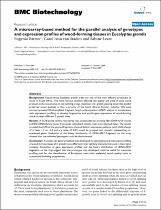 ResearchSpace
ResearchSpace
Microarray-based method for the parallel analysis of genotypes and expression profiles of wood-forming tissues in Eucalyptus grandis
JavaScript is disabled for your browser. Some features of this site may not work without it.
- ResearchSpace
- →
- Research Publications/Outputs
- →
- Journal Articles
- →
- View Item
| dc.contributor.author |
Barros, E

|
|
| dc.contributor.author |
Van Staden, C

|
|
| dc.contributor.author |
Lezar, S

|
|
| dc.date.accessioned | 2009-07-09T11:25:50Z | |
| dc.date.available | 2009-07-09T11:25:50Z | |
| dc.date.issued | 2009-05 | |
| dc.identifier.citation | Barros, C, Van Staden, C and Lezar, S. 2009. Microarray-based method for the parallel analysis of genotypes and expression profiles of wood-forming tissues in Eucalyptus grandis. BMC Biotechnology, Vol. 9(51), pp 1-12 | en |
| dc.identifier.issn | 1472-6750 | |
| dc.identifier.uri | http://hdl.handle.net/10204/3492 | |
| dc.description | Copyright: 2009 BioMed Central | en |
| dc.description.abstract | Fast-growing Eucalyptus grandis trees are one of the most efficient producers of wood in South Africa. The most serious problem affecting the quality and yield of solid wood products is the occurrence of end splitting in logs. Selection of Eucalyptus grandis planting stock that exhibit preferred wood qualities is thus a priority of the South African forestry industry. The researchers used microarray-based DNA-amplified fragment length polymorphism (AFLP) analysis in combination with expression profiling to develop fingerprints and profile gene expression of wood-forming tissue of seven different E. grandis trees. A 1578-probe cDNA microarray was constructed by arraying 768 cDNA-AFLP clones and 810 cDNA library clones from seven individual E. grandis trees onto silanised slides. The results revealed that 32% of the spotted fragments showed distinct expression patterns (with a fold change of at least 1.4 or -1.4 and a p value of 0.01) could be grouped into clusters representing coexpressed genes. Evaluation of the binary distribution of cDNA-AFLP fragments on the array showed that the individual genotypes could be discriminated. | en |
| dc.language.iso | en | en |
| dc.publisher | BioMed Central | en |
| dc.subject | Genotypes | en |
| dc.subject | Eucalyptus grandis | en |
| dc.subject | Biotechnology | en |
| dc.subject | Wood-forming tissue | en |
| dc.subject | Microarray prototype | en |
| dc.subject | cDNA-AFLP analysis | en |
| dc.subject | Grandis trees | en |
| dc.subject | BMC Biotechnology | en |
| dc.subject | Wood - South Africa | en |
| dc.title | Microarray-based method for the parallel analysis of genotypes and expression profiles of wood-forming tissues in Eucalyptus grandis | en |
| dc.type | Article | en |
| dc.identifier.apacitation | Barros, E., Van Staden, C., & Lezar, S. (2009). Microarray-based method for the parallel analysis of genotypes and expression profiles of wood-forming tissues in Eucalyptus grandis. http://hdl.handle.net/10204/3492 | en_ZA |
| dc.identifier.chicagocitation | Barros, E, C Van Staden, and S Lezar "Microarray-based method for the parallel analysis of genotypes and expression profiles of wood-forming tissues in Eucalyptus grandis." (2009) http://hdl.handle.net/10204/3492 | en_ZA |
| dc.identifier.vancouvercitation | Barros E, Van Staden C, Lezar S. Microarray-based method for the parallel analysis of genotypes and expression profiles of wood-forming tissues in Eucalyptus grandis. 2009; http://hdl.handle.net/10204/3492. | en_ZA |
| dc.identifier.ris | TY - Article AU - Barros, E AU - Van Staden, C AU - Lezar, S AB - Fast-growing Eucalyptus grandis trees are one of the most efficient producers of wood in South Africa. The most serious problem affecting the quality and yield of solid wood products is the occurrence of end splitting in logs. Selection of Eucalyptus grandis planting stock that exhibit preferred wood qualities is thus a priority of the South African forestry industry. The researchers used microarray-based DNA-amplified fragment length polymorphism (AFLP) analysis in combination with expression profiling to develop fingerprints and profile gene expression of wood-forming tissue of seven different E. grandis trees. A 1578-probe cDNA microarray was constructed by arraying 768 cDNA-AFLP clones and 810 cDNA library clones from seven individual E. grandis trees onto silanised slides. The results revealed that 32% of the spotted fragments showed distinct expression patterns (with a fold change of at least 1.4 or -1.4 and a p value of 0.01) could be grouped into clusters representing coexpressed genes. Evaluation of the binary distribution of cDNA-AFLP fragments on the array showed that the individual genotypes could be discriminated. DA - 2009-05 DB - ResearchSpace DP - CSIR KW - Genotypes KW - Eucalyptus grandis KW - Biotechnology KW - Wood-forming tissue KW - Microarray prototype KW - cDNA-AFLP analysis KW - Grandis trees KW - BMC Biotechnology KW - Wood - South Africa LK - https://researchspace.csir.co.za PY - 2009 SM - 1472-6750 T1 - Microarray-based method for the parallel analysis of genotypes and expression profiles of wood-forming tissues in Eucalyptus grandis TI - Microarray-based method for the parallel analysis of genotypes and expression profiles of wood-forming tissues in Eucalyptus grandis UR - http://hdl.handle.net/10204/3492 ER - | en_ZA |





